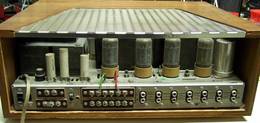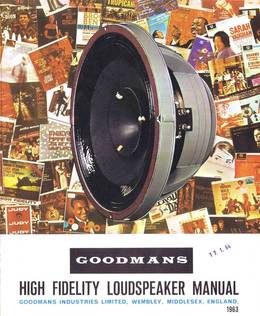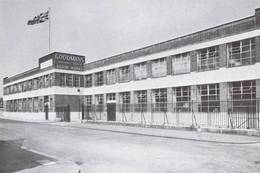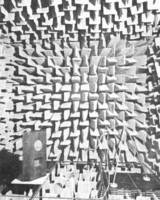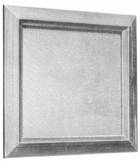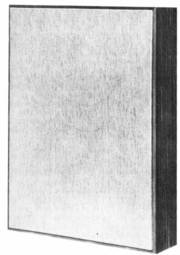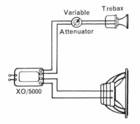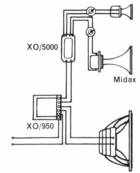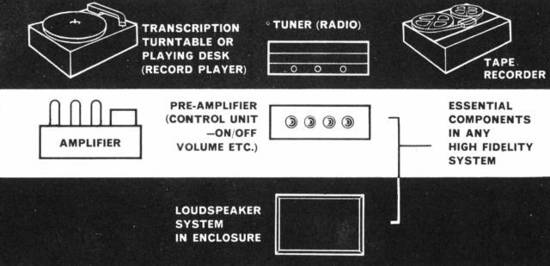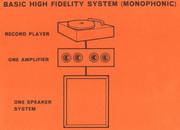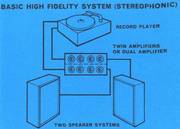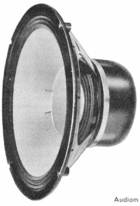Dieser 1963er Prospekt ist eine der ältesten "Broschüren"
von Gert Redllich im Juni 2017 - Zu der Zeit um 1963 war ich gerade mal 14 Jahre alt und konnte mit "solchen Sachen", wenn ich denn überhaupt darüber gestolpert wäre, nichts anfangen. -
Wolfgang Hasselbach hingegen war zu der Zeit (seit 1956) der Chefentwickler des Bereiches Audio bei der BRAUN AG in Frankfurt und hatte die Aufgabe bekommen, eine ganze Palette von damals besonders edlen Hifi-Geräten "quasi" aus dem Boden zu stampfen. Und er hatte alle - wirklich alle Prospekte akribisch gesammelt und gestempelt ... und aufgehoben. Ich durfte sie alle abholen.
Was ist das Besondere an diesem Prospekt aus 1963
Einmal kann man feststellen, daß Goodmans anfänglich auch eine Fabrik für Lautsprecher-Chassis war, sehr ähnlich zu der japanischen Firma PIONEER und auch zu Max Grundig. PIONEER hatte sogar als kleinster "Vater und Sohn" Reparaturbetrieb angefangen. Auch weitere englische Firmen haben als Chassis- Hersteller begonnen, dann auf Bausätze und dann erst auf komplette Boxen übergeschwenkt.
Das Zweite fällt bei den technischen Daten sofort ins Auge. Anfänglich wurden die verkraftbaren Verstärker-Leistungen sehr moderat spezifiziert. Da steht also bei einem dicken 15" Basslautsprecher nur etwas von 20 Watt (USA 40 Watt). Dieser Bolide würde heute mit mindestens 100 Watt hochgelobt.
1963 - Verstärker mit 2 x 35 Watt waren gigantisch
Wir können es uns heute kaum noch vorstellen, eine 2 x 35 Watt Röhren-Endstufe war der Übertraum der Hifi-Fans und nahezu unbezahlbar. Der wirklich kräftigste Hifi-Stereo-Verstärker war der McIntosch MC 275 für mehr als einen halben VW-Käfer.
Als bei uns im August 1963 zur Funkausstellung in Berlin unser deutsches UKW Stereo vorgestellt wurde, wurden für die Hifi-Stereo- Demonstrationen 16 oder 20 modifizierte Edel-Receiver SCOTT Stereomaster 380 aus Amerika eingeflogen. Und die 2 x 35 Watt Endstufe war die mit Abstand leistungsfähigste Endstufe, die vom "Sender Freies Berlin" (SFB) noch zu bezahlen war. Einer davon steht bei uns im Labor.
.
GOODMANS High Fidelity Loudspeaker Manual
GOODMANS INDUSTRIES LIMITED Wmbley, Middlesex 1963
In the pages of this manual you will find described the most comprehensive and advanced range of High Fidelity loudspeakers in Europe designed and manufactured by Goodmans Industries Limited, of Wembley, England.
In choosing your loudspeaker equipment be guided by the comments on each page relating them to your own individual requirements and existing equipment. In case you have any difficulty in making a choice, please do not hesitate to use Goodmans free advisory service-by telephone or letter-which is equipped to deal with all matters connected with sound reproduction.
If, however, you do not feel you can even begin to make a choice, you are invited to turn to 'Beginners Page' (page 17) which will help you, also to pages 18 and 19, which explain the mysteries and the delights of Stereophonic sound.
Goodmans Industries Limited, of Wembley, England, are the largest manufacturers of High Fidelity Loudspeakers in Europe. Their leading position has been gained by merit alone.
.
No manufacturing organisation can grow unless its products continually find very wide acceptance, in the face of world-wide competition. This condition is fulfilled by constant research and development, ensuring that the field is led, and not followed; and by attention to detail in all phases of design and production, to uphold a Tradition of Excellence, both mechanical and acoustical.
CONTENTS
| Page No. | |
| Acoustical Resistance Units .......... | ........... 9 |
| Attenuator..................................... | ...........15 |
| Audiom 51 (bass) ......................... | ...........10 |
| Audiom 61 (bass) ......................... | ...........10 |
| Audiom 81 (bass) ......................... | ...........11 |
| Audiom 90 (bass) ......................... | ...........12 |
| Axiette 8........................................ | ........... 4 |
| Axiom 10 ..................................... | ........... 5 |
| Axiom 80 ..................................... | ........... 8 |
| Axiom 201 ..................................... | ........... 6 |
| Axiom 301 ..................................... | ............ 7 |
| Crossover Networks ................... | ...............15 |
| Eleganzia .................................. | ...............13 |
| Enclosures............................ | ..... 4, 5, 6, 7, 8 & 11 |
| High Fidelity Stereophonic Sound.... | .....18 &19 |
| Introduction to High Fidelity ..... | ...............17 |
| Midax Mid-range Unit ................ | ...............15 |
| Special Purposes Audioms.......... | ..............12 |
| 'Stage-built' Systems................... | ...............16 |
| Three-Way Systems.................... | ..............16 |
| Trebax High Frequency Units....... | ..............14 |
| Two-Way Systems...................... | ..............16 |
.
Anechoic Test Chamber in Goodmans Laboratories
Pictured right is part of the anechoic chamber in the laboratory wing. The function of this room is to simulate free-space conditions.
Absolute acoustic measurements can be made to such a degree of accuracy that results obtained can be used not only for research and development, but also as a basis for discussion with national and commercial laboratories throughout the world.
The room occupies 4,500 cubic feet, and all its internal surfaces are lined with bonded glass-fibre 'wedges' 3 feet long. To minimise structurally borne vibrations within the room, the whole chamber, complete with its masonry, is resiliency suspended within the main building.
- Anmerkung : Das mit dem schalltoten Raum war bis Ende der 1960er Jahre ein tolles publikumwirksames Aushängeschild. Dann kam dieser neumodische Professor BOSE aus Amerika mit seinen 901 Boxen und erklärte den ganzen Rummel als absoluten Quatsch. Kein einziger Lautsprecher würde in einem schalltoten Wohnzimmer betrieben. Und er hatte Recht mit seinen Forschungen und Argumenten.
.
FULL RANGE SINGLE UNIT HIGH FIDELITY LOUDSPEAKERS
.
The 5 Loudspeakers described on this and subsequent pages under the heading 'Full Range single Unit High Fidelity Loudspeakers', are all designed to cover the full audible frequency range without assistance from any auxiliary units. In other words all that is necessary to complete the loudspeaker system is to mount one of these units in an enclosure of the correct design. Because the construction of these units is relatively uncomplicated they offer the best 'performance for money' value. Enclosure designs are given and further reference should be made to pages 4, 5, 6, 7 and 8.
AXIETTE 8 (8 inch - 6 watt - 15 ohm)
The latest model of the smallest true High Fidelity Loudspeaker produced features a new high efficiency permanent magnet system using FEROBA II anisotropic ceramic magnet material, allowing considerable reduction in magnet assembly depth. The unique hyperbolic diaphragm-plastic terminated, aluminium drive coil and magnet system are housed in a new precision diecast chassis of strong and slender design. Enclosure volume requirement only 3,000 cubic inches. This is an ideal speaker for stereophonic and monophonic installations.
AXIETTE 8 Specification
Frequency range............................................. 40-15,000 c/s
For amplifiers up to ..................... 6 watts (12 watts U.S.A.)
Fundamental resonance.............................................65 c/s
Flux density................................................... 13,500 gauss
Total flux................................................... 53,000 maxwells
Voice coil...........................1" (2-54 cm) diameter-aluminium
Impedance.........................................................15/16 ohms
Chassis............................................................... Diecast
Overall diameter ............................................. 8^-" (21 cm)
Overall depth...................................................3f" (9-2 cm)
Reflex enclosure volume (Internal) .................. 3,000 cu. ins.
Baffle hole diameter....................................... 1" (17-8 cm)
Fixing holes........................... 4 holes -fg (0-7 cm) diameter
equally spaced on 7§" (19-4 cm) P.CD.
Nett weight ................................................... 4 lbs (1.81 kg)
.
AXIOM 10 (10 inch - 10 watt - 15 ohm)
This very popular High Fidelity Loudspeaker bridges the gap between small installations (using the Axiette 8) and those involving large enclosures. It features a new magnet system in FEROBA II anisotropic ceramic magnet material, plastic terminated hyperbolic diaphragm and aluminium voice coil all housed in a precision diecast chassis. With a power handling capacity of 10 watts, and an enclosure volume requirement of only 5,000 cubic inches, the Axiom 10 is a highly satisfactory, yet economical, choice for all medium sized domestic High Fidelity installations.
AXIOM 10 Specification
Frequency range............................................. 40-15,000 c/s
For amplifiers up to..................... 10 watts (20 watts U.S.A.)
Fundamental resonance.............................................45 c/s
Flux density................................................... 13,500 gauss
Total flux................................................... 53,000 maxwells
Voice coil...........................1" (2-54 cm) diameter-aluminium
Impedance......................................................... 15/16 ohm
Chassis............................................................... Diecast
Overall diameter.......................................... 10" (26-6 cm)
Overall depth................................................ 4" (10-9 cm)
Reflex enclosure volume (Internal)..................... 5,000 cu.ins.
Baffle hole diameter....................................... 8 1/2" (21-6 cm)
Fixing holes.............................. 4 holes (0-6 cm) diameter equally spaced on 9"
(24-4 cm) P.C.D.
Nett weight....................................... 4 lbs 12 ozs (2.16 kg)
.
AXIOM 201 (12 inch - 15 watt - 15 ohm)
The Axiom 201 is an entirely new addition to the GOODMANS High Fidelity range, and is specially designed for High Fidelity enthusiasts who prefer a 12" Loudspeaker but do not need the high power handling capacity and the extra high efficiency of the AXIOM 301.
This remarkable twin diaphragm 12" unit has smooth performance from 30 to 16,000 c/s and can be used with amplifiers up to 15 watts. It has a plastic treated suspension, aluminium voice coil, powerful FEROBA II magnet assembly, and is mounted in an elegant diecast chassis of great strength and slender silhouette. Equally suitable for stereophonic or monophonic installations.
AXIOM 201 Specification
Frequency range............................................. 30-16,000 c/s
For amplifiers up to..................... 15 watts (30 watts U.S.A.)
Fundamental resonance.............................................35 c/s
Flux density................................................... 13,000 gauss
Total flux................................................... 87,500 maxwells
Voice coil........................ 1f" (4-4 cm) diameter-aluminium
Impedance...................................................... 15/16 ohms
Chassis............................................................... Diecast
Overall diameter.......................................... 12"(32-1 cm)
Overall depth................................................ 5" (13-2 cm)
ARU 172 enclosure volume (Internal)............... 7,800 cu.ins.
Baffle hole diameter.......................................... 11" (28 cm)
Fixing holes........................ 4 holes 0-312" (0-8 cm) diameter
equally spaced on 11 J* (298 cm) P.C.D.
Nett weight....................................... 9 lbs 12 ozs (4.43 kg)
AXIOM 301 (12 inch - 20 watt - 15 ohm)
The world's most popular 12" High Fidelity Twin Cone Loudspeaker now incorporates a highly efficient permanent magnet system using FEROBA II anisotropic ceramic magnet material.
All components are housed in a new diecast chassis of strong and graceful design. Very low level of distortion and exceptionally smooth and extended response is obtained from twin diaphragms which are specially terminated to prevent standing waves and spurious resonances and are driven by a long aluminium coil. The construction is dust proof of course. The Axiom 301 is ideal for single unit systems (stereo and monophonic) and is the recommended first step in the stage built system.
AXIOM 301 Specification
Frequency range............................................. 30-16,000 c/s
For amplifiers up to..................... 20 watts (40 watts U.S.A.)
Fundamental resonance.............................................35 c/s
Flux density................................................... 16,500 gauss
Total flux...................................................185,000 maxwells
Voice coil........................... 1 3/4" (4-4 cm) diameter-aluminium
Impedance...................................................... 15/16 ohms
Chassis........................................................ Diecast
Overall diameter.......................................... 12" (32-1 cm)
Overall depth................................................ 6"(15-6 cm)
ARU 172 enclosure volume (Internal)..................7,800 cu.ins
Baffle hole diameter.......................................... 11" (28 cm)
Fixing holes........................ 4 holes 0-312" (08 cm) diameter
equally spaced on 11" (29-8 cm) P.C.D.
Nett weight....................................... 17 lbs 10 ozs (8-0 kg)
AXIOM 80 (9 1/2 inch - 6 watt - 15 ohm)
A twin-cone transducer capable of the highest accuracy of sound reproduction at medium power levels. The moving assembly is 'free-edged', suspended on two sets of double-acting cantilevers which provide extremely low and linear axial stiffness combined with strong radial centering action. The Axiom 80 employs a cast chassis and suspension frame, and a highly efficient ring magnet system. Hand built throughout.
ACOUSTICAL RESISTANCE UNIT (A.R.U.)
.
Optimum low frequency performance can be obtained from the Axiom 80, Axiom 201, Axiom 301, and Audiom Bass Loudspeakers by the use of the enclosures shown on pages 6, 7 and 8. The most important feature of these enclosures is the inclusion in each of an Acoustical Resistance Unit.
This is a rectangular panel having specific acoustic properties, and it is fitted into an aperture cut in one wall of the enclosure. This system reduces the cone resonance both in amplitude and frequency and eliminates all serious resonances above this frequency.
As a consequence, transient characteristics are improved and harmonic and intermodulation distortion levels are reduced. No efficiency has been sacrificed; indeed these enclosures out-perform other considerably larger enclosures; e.g. conventional reflex enclosures, these in some cases requiring as much as four times the cubic volume for the same loudspeakers.
If it is desired to build an enclosure to suit individual requirements of shape, the A.R.U. will simplify many of the problems normally involved. It is essentially necessary to construct an enclosure of the correct internal volume and to cut two apertures (Öffnungen); one for the loudspeaker and one for the A.R.U. The latter is supplied mounted in a wooden frame which can be screwed directly to the edges of the aperture. Four models are available, each having been designed for use with a particular loudspeaker system.
.
Style and shape of the A.R.U.
Style and shape may be arranged to suit individual taste provided that the internal volume is within ±10% of the value given in the table. The A.R.U. may be fitted into any of the enclosure walls, but the shortest distance between the A.R.U. and the loudspeaker measured round or over the outside of the cabinet should not be less than one foot.
There should be no obstruction within 3" of the front of the A.R.U. The wooden frame is decorative and is normally fitted outside the enclosure, but performance is not affected if the fitting of the A.R.U. is reversed, e.g. in the front panel to present an unobstructed flat surface for covering with a decorative woven fabric material.
All enclosures should be close jointed and rigidly constructed of timber, chipboard, or material of similar or greater density and rigidity, not less than 3/4" thick. All internal surfaces (except the loudspeaker and A.R.U.) should be lined with 1" thick soft felt or wool, or cellulose wadding, and two curtains of the same material should be suspended from (approximately) the centre of the top of the enclosure, one 2" behind the other.
These curtains should be the full internal width of the enclosure, should extend from top to bottom of the interior and should not be fixed to sides and bottom. For detailed analysis of the operation of the A.R.U. see 'Loudspeaker Enclosure Design1 by E. J. Jordan, Goodmans Industries Limited in 'Wireless World', January and February, 1956. Reprints available free on request.
Details and Specifications are as follows :
| A.R.U. MODEL | LOUDSPEAKER TYPE(S) | ENCLOSURE VOLUME (cu.ins.) | A.R.U. APERTURE SIZE |
| 180 | ONE Axiom 80 | 5,900 | 12" x 1" (30-5 x 17-8 cm) |
| 280 | TWO Axiom 80's or ONE Audiom 81 Bass | 8,300 9,600 | 14" x 10" (36-8 x 25-4 cm) |
| 480 | FOUR Axiom 80's or ONE Audiom 90 Bass | 11,700 | 17 x 13" (44-4 x 34-3 cm) |
| 172 | Axiom 201 or Axiom 301 or Audiom 51 Bass or Audiom 61 Bass | 7,800 | 10" x 10" (26-7 x 25-4 cm) |
.
BASS UNITS FOR MULTIPLE SPEAKER HIGH FIDELITY SYSTEMS
AUDIOM BASS units are designed to cover only the bass portion of the musical register and all the features necessary for providing very accurate performance down to the lowest musical frequencies encountered are incorporated in their design. The necessary mid-range and high-frequency units for the completion of multiple systems will be found on pages 14 and 15 and enclosure details on page 6. Alternative versions are also available for Public Address work and for specialised applications such as electric guitars.
.
AUDIOM 51 BASS (12 inch - 15 watt - 15 ohm)
The AUDIOM 51 BASS is a rugged 12" single diaphragm unit handling up to 15 watts of power. It is specially designed for High Fidelity enthusiasts who need a 12" Loudspeaker as the Bass un'U in their three-way systems but who do not need the high power handling capacity and the extra high efficiency of the AUDIOM 61. The AUDIOM 51 BASS has a fundamental resonance of 35 c/s, and is fitted with a powerful FEROBA II magnet system giving high efficiency and control. A rigid diecast chassis holds all parts in permanent alignment; connection is by means of binding posts.
AUDIOM 51 BASS Specification
Maximum power handling capacity 15 watts (30 watts U.S.A.)
Fundamental resonance.............................................35 c/s
Flux density................................................... 13,000 gauss
Total flux................................................... 87,500 maxwells
Voice coil.......................................... 1J" (4-4 cm) diameter
Impedance.........................................................15/16 ohms
Chassis............................................................... Diecast
Overall diameter.......................................... 12f" (32-1 cm)
Overall depth................................................ 5-jV' (13-2 cm)
ARU 172 enclosure volume (Internal)............... 7,800 cu.ins.
Baffle hole diameter.......................................... 11" (28 cm)
Fixing holes........................ 4 holes 0-312" (0-8 cm) diameter
equally spaced on 11" (29-8 cm) P.C.D.
Nett weight....................................... 9 lbs 12 ozs (4-431 kg)
AUDIOM 61 BASS (12 inch - 20 watt - 15 ohm)
The AUDIOM 61 BASS is a very robust 12" single diaphragm unit handling up to 20 watts of power. It is fitted with a massive FEROBA II magnet system giving exceptional efficiency and control. With its low fundamental resonance of 35 c/s- it is the ideal choice as the Bass unit in a three-way system incorporating the MIDAX and TREBAX. A rigid diecast chassis of advanced design holds all parts in permanentandaccuratealignment. Binding posts are fitted for rapid and secure connection.
AUDIOM 61 BASS Specification
Maximum power handling capacity 20 watts (40 watts U.S.A.)
Fundamental resonance.............................................35 c/s
Flux density................................................... 16,500 gauss
Total flux...................................................185,000 maxwells
Voice coil.......................................... If" (4-4 cm) diameter
Impedance.........................................................15/16 ohms
Chassis..................................................................Diecast
Overall diameter.......................................... 12f" (32 1 cm)
Overall depth................................................ 6^"(15-6 cm)
ARU 172 enclosure volume (Internal)..................7,800 cu.ins.
Baffle hole diameter.......................................... 11" (28 cm)
Fixing holes........................ 4 holes 0312" (08 cm) diameter
equally spaced on 11" (29-8 cm) P.C.D.
Nett weight....................................... 17lbs 10 ozs (80 kg)
AUDIOM 81 BASS (15 inch - 25 watt - 15 ohm)
The AUDIOM 81 BASS is a rugged 15" single diaphragm Bass unit of new heavy duty construction and handling up to 25 watts. It is fitted with a massive FEROBA II magnet system and 3" voice coil thus combining a shallower assembly and up-to-the-minute styling with exceptional ruggedness in use and the ability to handle high power. The rigid diecast chassis is of exceptional strength. The cone edge is plastic treated to give correct termination. Binding posts are fitted for rapid and secure connection.
AUDIOM 81 BASS Specification
Maximum power handling capacity 25 watts (50 watts U.S.A.)
Fundamental resonance.............................................25 c/s
Flux density................................................... 14,000 gauss
Total flux...................................................269,000 maxwells
Voice coil.............................................3" (7-6 cm) diameter
Impedance.........................................................15/16 ohms
Chassis..................................................................Diecast
Overall diameter.......................................... 15-fV (38-2 cm)
Overall depth................................................ 6^" (160 cm)
ARU 280 enclosure volume (Internal)............... 9,600 cu.ins.
Baffle hole diameter....................................... 13^" (33-8 cm)
Fixing holes........................... 8 slots i"x-fe" (0-95 cm x
0-8 cm) on 14^" (36-9 cm) P.C.D.
Nett weight................................................ 20 lbs (9075 kg)
SPECIAL PURPOSE AUDIOMS
.
Three versions of the Audiom 51 and Audiom 61 are available. For the majority of High Fidelity and High Quality applications the Audiom 51 (Bass) or 61 (Bass) with 35 c/s fundamental resonance (Bass-Resonanz) is recommended. This recommendation assumes that the loudspeaker will be properly mounted in a correctly designed and constructed enclosure, such as one of those described on pages 6 and 7. Under these circumstances first class reproduction down to below 30 c/s will be achieved.
However, these Bass versions should never be chosen when an incorrect or inadequate enclosure is to be used, as they will not then have the opportunity to achieve this extended bass response and they may also suffer damage from the excessive diaphragm movement permitted by insufficient enclosure loading.
For much Public Address work, and for cases where the conditions of service are particularly arduous, the Audiom 51 or 61 with 75 c/s fundamental resonance should be used. This resonance is also a wise choice for electric bass guitars and similar instruments, especially when these are being used at full power, and with loudspeaker enclosures which, because of the requirements of portability, are smaller than the optimum size and therefore do not provide full acoustic loading for the diaphragm. Under these conditions the Audiom 61 (75 c/s) is the preferable choice.
A fundamental resonance of 55 c/s can be supplied for special applications, on either model. The 15" Audiom 81 has a higher power handling capacity than the 12" Audioms, but requires a larger enclosure for correct operation, as shown on page 11.
An 18" unit, the Audiom 90 is available for very high power applications. It has a handling capacity of 50 watts for normal speech and music signals and it is a standard unit for musical instrument amplifiers, electronic organs, Church belfries (reproduced bells) etc. It should be noted that the power rating must be modified according to the type of signal being reproduced. In addition, the Audiom 90 may be used as a bass unit in multiple unit High Fidelity systems. Enclosure requirements are 11,700 cubic inches internal volume, using A.R.U. 480.
COMPLETE HIGH FIDELITY LOUDSPEAKER SYSTEM
.
ELEGANZIA
A major achievement is marked by the introduction of this complete 15 watt High Fidelity Loudspeaker system. The ELEGANZIA not only sets a new standard for accurate, high-definition sound reproduction, but achieves it in a total depth of only 6". This means that it need not intrude into living space even in small rooms - while its generous power handling capacity makes it just as good a choice for large rooms. Only 27" high and 20" wide, its very simplicity of styling is dramatic.
Inside this intriguing enclosure are two loudspeakers, each the result of many months of careful development directed towards the production of bass and treble units specifically for operation in a very shallow enclosure.
The 12" bass unit is unique in being the first loudspeaker in this country to employ Goodmans SUPRFOAM diaphragm. (Pat. app. for). This is a composite diaphragm employing a lightweight impermeable cellular plastic which fulfils two functions. It provides the felted fibre piston with elements of mechanical resistance, with hardly any additional mass, producing the best diaphragm behaviour control yet devised. In addition, it forms the diaphragm edge suspension and allows very large linear excursions with perfect diaphragm termination. It should be noted that the Suprfoam diaphragm is in no way similar to the commonly used expanded polystyrene diaphragms.
An extra-long voice coil to maintain constant drive conditions at high amplitude and a deep roll centre suspension complete the moving assembly which is mounted in a super-slim diecast chassis that has been designed and produced specially for this reproducer. Finally, the chassis contains a powerful FEROBA II magnet system, operating at maximum efficiency.
At 900 c/s an L.C. crossover network transfers the electrical drive to a new back loaded mid-range and high-frequency unit, which consists of a sealed direct radiator with graded diaphragm constants to produce linear performance to beyond 15Kc/s with a broad polar characteristic.
Both loudspeakers are sealed into the enclosure so that the bass diaphragm operates on an 'air cushion' which forms a large part of the total suspension stiffness, another factor in the remarkably low distortion characteristics of this reproducer.
ELEGANZIA Specification
Dimensions........................ 27" high x 20" wide x 63" deep
(68-6 cm x 50-8 cm X 159 cm)
Frequency range............................................. 35-15,000 c/s
Power handling capacity....................................... 15 watts
Impedance.........................................................15/16 ohms
MID-RANGE AND HIGH FREQUENCY UNITS FOR MULTIPLE SPEAKER HIGH FIDELITY SYSTEMS
.
The pressure-driven horn-loaded loudspeakers shown on this page have been designed specifically for use with the Audiom Bass units to form very low distortion multiple unit High Fidelity loudspeaker systems. The 12" Axiom loudspeakers (pages 6 and 7) are equally suitable as bass units, and should be used if the 'Stage-Built' System (page 16) is being followed, or if a two-way system only is required, with one of the Trebax High Frequency Units.
The system power handling capacity figures quoted below imply that the units may be incorporated (with crossover frequencies as specified) in multiple systems handling these powers on speech or music programme inputs. To enable Trebax and Midax units to be used with Horn-loaded bass units, if required, sensitivity has been made very high. A more usual application, however, will be in conjunction with direct radiator bass units, such as the Audiom series. In such cases some attenuation of the inputs to the Trebax and Midax units will be necessary to provide a flat overall response. A variable attenuator has been designed for this purpose and is fully described on page 15. A series of crossover networks for use with Trebax and Midax is also shown on page 15.
.
TREBAX HIGH FREQUENCY PRESSURE UNITS
TREBAX 100
A very high efficiency horn-loaded pressure driven high frequency unit designed to cover the treble register with complete freedom from irregularities in response, and with very low distortion. Trebax is a precision instrument, incorporating a self-centering coil and diaphragm assembly complete with plug connector. This assembly can be replaced without the use of special tools in case of accidental damage. The frequency range is from 2,500 c/s to 20,000 c/s. To allow the proper overlap region the crossover frequency should be placed at 5Kc/s.
TREBAX 100 Specification
Frequency range..........................................2,500-20,000 c/s
Crossover frequency............................................. 5,000 c/s
System power handling capacity... 25 watts (50 watts U.S.A.)
Impedance............................................. 15 ohms at 10Kc/s.
Baffle hole diameter..-........................................ 1 7/8" (4-8 cm)
Fixing holes (Horn flange)......3 holes 0-156" (0-4 cm) diameter
on 3 2^(5-7 cm) P.CD.
TREBAX 5K/20XL
A high efficiency pressure driven horn-loaded High Frequency unit with BUILT-IN (Twin 1/4-section L.C.) crossover network, ready wired, complete with 15 ohm L-pad on 2 ft. (61cm) cable. The TREBAX 5K/20XL has a frequency coverage of 2,500 c/s to 20,000 c/s, and may be used in systems handling up to 20 watts (maximum). The crossover frequency of the built-in network is 5,000 c/s.
To add the unit to any existing loudspeaker system (e.g. Axiom 10, 201 etc.), it is only necessary to transfer the input leads on the existing loudspeaker to the terminals marked 'INPUT' on the Trebax, and then to connect the existing unit to the terminals marked 'BASS', on the Trebax.
TREBAX 5K/20XL Specification
Frequency range..........................................2,500-20,000 c/s
Crossover frequency.....................5,000 c/s (built in network)
System power handling capacity..................... 20 watts max.
Impedance............................................. 15 ohms at 10Kc/s.
Construction of Driver............... Aluminium diaphragm and
voice coil with integral air chamber in removable self-aligning assembly
Baffle cut-out........................... 1 1/8" x 2 3/8" (2-9 cm x 6-0 cm)
Attenuator fixing..................3 holes, 0-156" (0-4 cm) diameter
on 2"(6-3 cm) P.CD.
Attenuator cut-out........................... 2 3/16"(5-5 cm) diameter
MIDAX MID-RANGE PRESSURE DRIVEN HORN UNIT
This unit is the correct choice when the major advantages of a horn-loaded middle register loudspeaker are required (i.e. freedom from distortion, smoothness of response, and high efficiency). The total frequency range covered by the Midax 650 is 650 c/s to8Kc/s; to make proper allowance for the overlap regions crossover frequencies should be 950 c/s and 5Kc/s. The horn is an attractive and sturdy diecasting; reliable plug and socket connections are provided, and an easily replaced self-centering diaphragm is fitted.
Specification
Frequency range............................................. 650-8,000 c/s
Crossover frequencies.............................. 950 and 5,000 c/s
System power handling capacity ... 25 watts (50 watts U.S.A.)
Impedance............................................................15 ohms
Baffle cut-out........................ 5f" x 2TV(14-3cm x 6-5 cm)
with -|V (0-79 cm) radii at corners
Fixing holes (Horn flange)... 6 holes 0-19T (0-4 cm) diameter
Overall length................................................9-ff" (25-3 cm)
.
ATTENUATOR, VARIABLE, 12db 8-STEP
This accessory is designed for use with the Midax and Trebax units to enable easy and accurate balancing of the two-way or three-way systems. The attenuator is of the constant impedance type, so that at all settings it will present an impedance of 15 ohms at its input, when connected to a 15-ohm load, such as the Midax or Trebax. It is variable in eight steps as follows: - Odb, 2db, 4db, 6db, 8db, 10db, 12db, and off. In the "off" position (fully anticlockwise) the loudspeaker under control is switched off altogether and a dummy load automatically replaces it to maintain correct matching. This position is useful when checking the operation of the various loudspeaker units in a multiple system.
In the systems described on page 14 the settings of the attenuators for level response will normally lie between the 2db and 8db positions, depending on the choice of bass units. There is thus effectively a facility for "boost" or "cut" available with these controls. This enables a system to be adjusted to suit the characteristics of any particular room in which it may be used.
There is also sufficient scope to allow for individual preferences and special requirements. Another useful feature lies in the ability of these controls to "tailor" the response to an extreme degree as it is often necessary, for example, when playing pre-electric recordings. In such cases it is often desirable to remove all response above 5Kc/s; and this is easily done by switching the Trebax attenuator to the "off" position. The attenuator is supplied complete with knob and engraved escutcheon, (cut-out required 2-rV - 5.5 cm.dia.).
GOODMANS STAGE-BUILT' HIGH FIDELITY LOUDSPEAKER SYSTEMS
The 'Stage-Built' system is a method of building up a multiple unit High Fidelity reproducer having a performance of the highest order. As there are three stages the total outlay for the complete system can be split up into three parts to suit individual convenience. The main feature of the 'Stage-Built' system is that each stage is a complete full range High Fidelity reproducer, which is improved by the addition of the next stage. Thus at no time is the user without an excellent High Fidelity loudspeaker; neither is there any wastage of components, since all parts used in one stage are automatically used in successive stage(s). By this means it will be realised how it is possible to improve the quality of the loudspeaker system in a most economical manner as and when the remainder of the apparatus (pickup, amplifier, etc.) is improved.
STAGE 1
Comprises one of the 12" twin-cone Axiom loudspeakers; either the Axiom 201 (15 watts) or the Axiom 301 (20 watts), depending upon the power handling capacity required. (It should be remembered that at this stage the choice of power handling capacity fixes that figure for the remaining two stages.)
Full details of the Axiom 201 and Axiom 301 are given on pages 6 and 7.
The choice of an enclosure is very important at this stage. If it is planned to ultimately proceed right through to Stage 3, it is then advisable to use the three-way system Enclosure from the start, with the apertures for the Midax and Trebax blanked off until required. (Enclosure design page 6.)
STAGE 2
In this stage the 12" twin-cone Axiom loudspeaker chosen for Stage 1 is used to cover the bass and mid-frequency range only, up to 5,000 c/s, from which point the Trebax pressure-driven horn loaded high frequency unit (described on page 12) covers the remainder of the range up to and beyond 16,000 c/s.
Crossover network XO/5000 (page 15) is used to perform the frequency division, and the eight-step 12 db variable attenuator (page 15) is used to provide adjustment of high frequency output. Note that, since the Trebax is more sensitive than the Axiom 201 or the Axiom 301, this control will have the useful function of treble " cut " or " boost." (Note: If the Stage 1 unit is AXIOM 201 and it is not intended to go beyond Stage 2, the TREBAX 5K/20XL may be used in Stage 2. This unit is already complete with its own XO network and attenuator.)
STAGE 3
This final stage is the conversion of the two-way system of Stage 2 to a three-way system, by the addition of the Midax pressure-driven horn loaded unit. This takes over the reproduction of the mid-range frequencies (950-5,000 c/s) from the 12" twin-cone Axiom, which is now called on to cover the bass range only. A 950 c/s crossover network type XO/950 (page 15) performs this extra frequency division and another eight-step 12 db variable attenuator is added to provide adjustment of the mid-range output.
The system is now completed. If all instructions have been correctly followed, the result will be an outstanding reproducer. When a three-way system is to be built, complete from the start, and not in stages, a multiple crossover type XO/950/5000 may be used instead of separate crossover types XO/950 and XO/5000. Also in these circumstances an AUDIOM BASS Unit may be used instead of an AXIOM-but not in a two-way system.
INTRODUCTION TO HIGH FIDELITY
.
ALL RADIO RECEIVERS, RADIOGRAMS AND RECORD PLAYERS CONTAIN AN AMPLIFIER AND A LOUDSPEAKER.
In many cases the quality of the amplifier and loudspeaker is governed by considerations of cost and although the resulting sound quality is adequate for general entertainment it cannot produce the sense of being actually 'there'-at the live performance. To be 'there' you need really faithful sound reproduction -High Fidelity- and this can only be achieved by the use of an amplifier and loudspeaker which have been designed without compromise, for this very purpose. Naturally, the gramophone pickup, microphone, tape or radio unit which feed the amplifier must be of the same high order of quality, as also must be the signal source itself, whether it be a record, a tape, or an F.M. broadcast.
BUILDING THE SYSTEM
In building up a High Fidelity system you may want to use any or all of these signal sources, but you will only need one amplifier and loudspeaker system! Figure 1 shows very simply the main components of a complete installation.
The 'control unit' is part of the amplifier and is also called a preamplifier; it contains the controls for volume, treble and bass etc., and is usually physically separate from the main part of the amplifier so that it can be installed in a position where the controls are conveniently to hand.
It also contains a selector switch which connects the gramophone pickup, tape recorder, radio or other sound source to the amplifier. All the components shown in the diagram, except the loudspeaker, can be built into the same cabinet, or 'built-in' to a room in any way that you wish (e.g. shelves, room dividers, etc.)
The loudspeaker, however, needs its own specially designed enclosure it if is to perform properly. Details of suitable enclosures are given in this manual. The system in figure 1 is a monophonic system; on page 18 you will find a description of this type of system, and also an explanation of stereophonic systems, and their advantages.
HOW MUCH TO SPEND
Whatever installation you decide upon, you will have to choose a loudspeaker to do justice to the rest of the equipment. Your choice will be governed by three main considerations.
(1) The amount you are prepared to spend on the loudspeaker system.
(2) The size of the room in which it is to be used.
(3) The possibility of later development of the system.
A useful guide to expenditure on the different parts of a High Fidelity system is to divide the total into three roughly equal parts - so that you spend about the same amount on the loudspeaker and its enclosure as you spend on the amplifier with preamplifier, and about the same amount again on each signal source. (There is an exception here - a radio unit will probably cost less than a pickup and turntable or a tape recorder of comparable quality).
NOW FOR THE LOUDSPEAKER
The size of room to be used influences the size of loudspeaker needed. A small loudspeaker (e.g. AXIETTE 8 or AXIOM 10, pages 4 and 5) would be large enough for most small sitting rooms, and in addition the enclosure is compact. However, there is no bar to using a larger loudspeaker (e.g. AXIOM 201 or AXIOM 301, pages6and7) inasmall room, except that the enclosure is rather larger. There is often a fear in people's minds that a large loudspeaker will be 'too loud'. This is quite unfounded, as the loudness is under your control at all times.
A large loudspeaker is capable of producing a larger volume of sound than a small one, so it may be worth considering if it is likely that your 'Hi-Fi' might later be moved into a larger room.
HIGH FIDELITY STEREOPHONIC SOUND REPRODUCTION
.
The introduction of Stereophonic sound reproduction is the most important single step towards greater accuracy and realism of sound reproduction that has taken place for many years.
Until recently every advance that was made simply concerned further refinements of the 'monophonic' system, which is still employed in all radios, and many radiograms and record players.
Always the sound came from one spot only - the loudspeaker - and no matter how large the orchestra or how wide the operatic stage, all were compressed in size into one small area at the receiving end. At best, the situation was similar to having one's sitting room connected directly to the concert hall by a small hole in the wall.
All sense of the position of the different instruments or of the direction of movement of actors was lost. Imagine now that you can put head and shoulders through that hole in the wall. At once the scene broadens, and the ears can take up their function as direction-finders. You are in the concert hall. Stereophonic equipment can do this for you in conjunction with stereophonic records or tape.
THINKING IN TERMS OF TWO!
The records after 1958 contain two different impressions in the same groove; these represent the signalsfrom two separate microphones spaced apart in front of the performers.
The pickup used in your stereophonic equipment converts these impressions into two sets of electrical impulses and passes them to two separate amplifiers. Thence they go to separate loudspeakers, also spaced apart.
You, sitting in front of the loudspeakers, and roughly equidistant from each of them, will have the whole sound picture built up before you, with everything in its right place. If a performer moved across the stage in the original performance you will hear him do so between your loudspeakers.
It is hardly necessary to dwell on the vast improvement in realism that is gained in this way. It is similar to the difference between an ordinary 'flat' picture and a 'three-dimensional' one, (which again is composed of two separate pictures, taken from different viewpoints). WITH HIGH FIDELITY ADDED, THE PICTURE IS NOT ONLY THREE-DIMENSIONAL, BUT IN FULL COLOUR TOO.
What is needed to install Stereophonic High Fidelity in your Home?
.
FIRST OF COURSE A TURNTABLE
It does not pay to buy a cheap one; your listening pleasure can be completely spoilt by slow variations of speed (called 'wow') or rapid ones (called 'flutter'), or by a noisy mechanism which will pass noises like distant thunder ('rumble') through to your loudspeakers. A good turntable ('transcription' type), not a record changer, will be almost completely free of all these faults. You may want to play some of your existing 78 r.p.m. records as well (stereophonic records are 33 or 45 r.p.m.) so a 3-speed turntable is a wise investment.
- Anmerkung : Vermutlich hatten die Goodmans Werbetexter die Hannover Messe 1963 nicht sorgfältig genug "abgegrast" und auf der Funkausstellung im Herbst 1963 dann auch nicht genug aufgepaßt. Denn dann wären ihnen beide Male der brand neue DUAL 1009 ins Auge gefallen, der alle diese Macken nicht mehr hatte.
.
NEXT A PICKUP
A good stereophonic pickup is a light and comparatively delicate affair, but it will not be damaged in normal use. Most models have a removable head, which can be put away safely when not in use. A completely separate pickup and arm should be fitted for playing ordinary (monophonic) recordings, and this can be more robust, to withstand normal family use if necessary.
Specialist advice should be sought as to the exact choice of pickups: as a general rule to guide expenditure on the complete equipment it would be reasonable to spend equal amounts on (a) turntable and pickup, (b) amplifier, (c) two loudspeakers.
THE AMPLIFIER
As mentioned already, the amplifier actually consists of two separate amplifiers though they may be assembled on one chassis. The controls(volume, treble, bass, etc.) for both amplifiers are usually 'ganged' so that there are no more controls than on an ordinary equipment, excepting a 'balance' control which enables the two channels to be adjusted to an exactly equal degree of amplification. For normal domestic installations an amplifier having a power output of 10 watts in each channel will be found quite adequate.
- Anmerkung : Wie wir im Original-Prospekt gesehen hatten (ich habe es hier weggelassen), werden für fast jedes Chassis mehrere riesige Gehäuse zum Einbau vorgeschlagen, sogar samt der Gehäusewand-Stärke. Da könnten mit einem der damaligen mittelmäßigen Plattenspieler diese 10 Watt (an 4, 8 und 16 Ohm !! ) pro Kanal für leise Zimmerlautstärke gerade so ausgereicht haben.
.
FINALLY THE LOUDSPEAKERS
Since care has been taken all through the recording and reproducing chain to give each of the two signals identical treatment, it is wise to employ two loudspeakers of the same type. Any of the full range High Fidelity loudspeakers or loudspeaker systems described in the earlier pages may be used; the exact choice will be governed by the power handling capacity required (this ought not to be less than the power output of the amplifier) and by the space which can be given up to the loudspeaker enclosures. It will be noticed that several very compact models are available, and these are of especial value when space is limited. The installation of the equipment is comparatively simple, but if in any doubt seek the readily available expert guidance.
POSITIONING THE LOUDSPEAKERS
This is particularly important. Normally the stereophonic effect will be experienced in a roughly triangular area, the apex of the triangle being mid-way between the loudspeakers. It will be found to be impossible to extend this area to cover the whole room, but it will be found quite possible to arrange the loudspeakers so that a small group of people can enjoy satisfactory reproduction without abnormal arrangement of furniture.
Optimum loudspeaker spacing will be about 8 feet for most rooms with listening position preferably more than about 10 feet away from each unit. Since no two rooms are acoustically alike, precise guidance is not possible, and a little experiment will prove to be worthwhile.
It is vitally important that the loudspeakers should be 'phased' correctly. If the connections to one of the loudspeakers should happen to be reversed, the sound picture will not be correct. One of the quickest ways to check for correct phasing is to place the two loudspeakers about one foot apart, facing each other. Put on a stereophonic record of a vocalist, and listen with your head between the loudspeakers, one close to each ear.
If all is well, the singer will appear to be in front of you. If the phasing is incorrect, he will be difficult to locate, and there will appear to be a reduction in the loudness of the bass parts of music. A reversal of the leads to one loudspeaker only will put the situation right.
Apart from the actual spacing of the loudspeakers some experiment should be carried out with small variations of the direction in which they face. If, for example, the loudspeakers are located against the shorter wall of a room, start with them both facing straight down the length of the room. Move about the room while playing a stereophonic recording and try to judge the boundaries of the listening area in which the stereophonic effect is satisfactory. Turn both loudspeakers inwards slightly, and repeat the experiment. The object is to try to achieve a satisfactory listening area that corresponds with convenient seating arrangement.
.
In einem Beilageblatt werden die "G" Typen beschrieben
.
GOODMANS "G" RANGE HIGH FIDELITY LOUDSPEAKERS
This section describes Goodmans "G" Range High Fidelity Loudspeakers. In addition to the many types shown elsewhere in Goodmans High Fidelity Loudspeaker Manual, Goodmans Industries manufacture a range of luxury specification High Fidelity Loudspeakers exclusively for export to overseas countries, each class of loudspeaker representing a fine example of British craftsmanship and precision engineering.
The "G" Range consists mostly of two-element and three-element types, to span the maximum frequency range with a single loudspeaker. But for those who prefer the facility of middle frequencies also to be reproduced by a horn loaded pressure unit, there are high-powered Audiom Bass loudspeakers, "Midax" midrange and "Trebax" treble horn units, to enable a perfectly matched multi-speaker system to be installed in a normal size enclosure.
The enclosure designs in the Goodmans High Fidelity Loudspeaker Manual are suitable for all Goodmans High Fidelity loudspeakers of the stated size.
8" Full Range High Fidelity Loudspeakers
.
TWINAXIETTE 8
A High Fidelity 8" twin-cone loudspeaker of outstanding quality,capable of a standard of performance hitherto associated only with much larger or elaborate loudspeaker equipment. The Twin Axiette has a plasticised edge curvilinear main cone with coaxially mounted high-frequency cone both driven from a common voice coil, the crossover being entirely mechanical.
TRIAXIOM 8
A three-element loudspeaker of similar construction to the TwinAxiette 8 but with a separate coaxially mounted H.F. unit, electrical crossover, variable L-pad. Both these loudspeakers employ the same space-saving reflex enclosure as the Axiette 8, details of which are shown in the Goodmans High Fidelity Loudspeaker Manual.
Improved recording techniques and F.M. broadcasting standards demand near perfection from modern High Fidelity loudspeakers, but space considerations, especially for stereophonic sound reproduction, often deny the use of large loudspeaker systems. With the outstanding performance of Goodmans Triaxiom 8 and TwinAxiette 8, in their compact enclosures, the problem no longer exists.
Special Features include:
Prodigious power handling. Low distortion-high definition. Superb transients and sensitivity.
Smooth overall response. Very extended frequency coverage. Unitary diecast frame of slender profile. Heavy magnet system. Variable L-pad brilliance control on Triaxiom 8.
| Specification | TWINAXIETTE 8 | TRIAXIOM 8 |
| Frequency Range | 40-18,000 c.p.s. | 40-20,000 c.p.s. |
| Impedance | 15/16 ohms | 15/16 ohms |
| Main Magnet Weight | lb. | |
| Power Suitability | 15 watts (U.S.A.) | 15 watts (U.S.A.) |
| Fundamental Resonance | 65 c.p.s. | 65 c.p.s. |
| Flux Density | 13,500 gauss | 13,500 gauss |
| Voice Coil Diameter | 1" Aluminium | 1" (HF& LF) |
| Crossover: Mechanical at | 2,000 c.p.s. | 2,000 c.p.s. |
| Crossover: Electrical at | - | 5,000 c.p.s. |
| Baffle Hole Diameter | 7" (17 8 cms) | 7" (17-8 cms) |
.
10" Full Range High Fidelity Loudspeakers
.
General Description and Specification
The 10" TwinAxiom and Triaxiom loudspeakers provide an excellent choice for most domestic monophonic and stereo-phonic High Fidelity equipment employing amplifier powers not greater than 10 watts r.m.s. (20 watts U.S.A.) per channel. These 10" loudspeakers have adequate cone area to produce generous bass, yet require relatively compact enclosures.
TwinAxiom 10. This has a duplex cone and aluminium voice coil construction, similar to that of the 12" Axiom models, to provide a low mass moving system with extended range and excellent transient response. The Twin Axiom 10 has a plasticised edge main cone and concentrically mounted tweeter cone. Crossover is mechanical. Frequency range: 40-18,000 c.p.s.
Triaxiom 10. Of basically similar structure to the Twin-AxiomlO, but has additionally a coaxially positioned pressure-driven lens-type H.F. unit, thus extending the response to 20Kc/s. A pre-wired L-pad control permits instant adjustment of the output level to suit varying room or programme listening conditions. Frequency range: 40-20,000 c.p.s.
Specification
Impedance......................................15/16 ohms
Magnet Weight.........................................fib.
Flux Density...................................13,500 gauss
Fundamental Resonance.............................45 c.p.s.
Power Suitability...........................20 watts (U.S.A.)
12" and 15" Triaxiom 3-element High Fidelity Loudspeakers
In the Triaxiom design, three concentrically mounted radiating elements co-operate smoothly to reproduce the entire audio frequency range with a single loudspeaker, based on the "point source" principle.
Bass, mid-range and treble frequencies are reproduced by separate but integrated radiating elements, each working at optimum efficiency over its particular frequency band. This design provides also the facility to adjust the treble response at will to suit room or programme conditions, and personal preference.
Spanning more than nine octaves, Goodmans Triaxiom loudspeakers encompass the whole musical register, to recreate in full the tonal quality of each instrument from its fundamental to the highest audible overtone.
- Anmerkung : Der Triaxiom 15 war der zur Zeit leistungsstärkste Lautsprecher im Goodmanns Programm. Laut Datenblatt konnte man ihn mit 50 Watt Musikleistung betreiben und das war damals schon sehr viel.
.
De Luxe Features include:
The Triaxiom loudspeaker brings professional standard High Fidelity to domestic listening with just a single uncomplicated unit and in the standard A.R.U. enclosure needs but little floor space.
Massive unitary diecast chassis. Plastic terminated "Rigidflex" diaphragm for rich undistorted bass. - Extra-long 3" diameter voice coil for effortless power handling.
High efficiency Feroba II Magnet. - Automatic crossover to high stability mid-range radiator. - Pressure driven horn loaded high-frequency unit, with aluminium diaphragm and voice coil in self aligning assembly with air chamber and phase equaliser. - Pre-wired 5 Kc/s L.C. network and constant impedance L-pad attenuator for H.F. level balancing. - Phased terminals for ease of stereophonic hook-up.
.
Specifications - Triaxiom Loudspeakers - 12" and 15" models
| Type and Size | 12"-212 c | 12"-612c | 15"-215 c | 15"-615 c |
| Frequency Range, c.p.s. | 30-20,000 | 30-20,000 | 25-20,000 | 25-20,000 |
| Fundamental Resonance | 35 c.p.s. | 35 c.p.s. | 25 c.p.s. | 25 c.p.s. |
| Enclosure Volume using ARU | 7,800 cu. ins. | 7,800 cu. ins. | 9,600 cu. ins. | 9,600 cu. ins. |
| ARU 172 | ARU 172 | ARU 280 | ARU 280 | |
| Power* Suitability (watts) | 30(15) | 40 (20) | 40 (20) | 50 (25) |
| Impedance (ohms) | 15/16 | 15/16 | 15/16 | 15/16 |
| Total Flux, maxwells | 157,000 | 269,000 | 157,000 | 269,000 |
| Overall Diameter | 12f" (32 1 cms) | 12f"(32-1 cms) | 15i" (38-5 cms) | 15£" (38-5 cms) |
| Overall Depth | 5-&"(13-2 cms) | 5tV' (13-2 cms) | 6^" (16-5 cms) | 6£" (16 5 cms) |
| Nett Weight | 15 lbs. (7 kgs) | 21±lbs. (10 kgs) | 15 lbs. (7 kgs) | 21± lbs. (10 kgs) |
.
*Power rating figures show U.S.A. and, in brackets, r.m.s. values. For enclosure particulars and fixing hole diameters, please see Goodmans High Fidelity Loudspeaker Manual.pages 6, 7 and 11.
.
Multi-Speaker High Fidelity Loudspeaker Systems
Pressure driven horn loaded units are generally more efficient and smoother in response than cone-type loudspeakers, but only over the limited frequency range which each is intended to cover. Combining the advantages of a fine bass speaker with horn loaded middle and treble units permits therefore, lower intermodulation distortion, smoother overall response, and the facility to adjust the performance of each component in the system according to personal preference or surroundings.
Such multi-speaker systems are fully described on pages 10 and 11 of Goodmans High Fidelity Loudspeaker Manual.
In the "G" range, the bass loudspeaker is the powerful 12" Audiom 852 with the following luxury specification:
AUDIOM 852 Specification
Fundamental Resonance.............................35 c.p.s.
Frequency Response in Enclosure down to............30 c.p.s.
Power Suitability for systems not exceeding........., .40 watts (20 watts r.m.s.)
Voice Coil Diameter......................................3"
Tote/ Flux..................................308,000 maxwells
Nett Weight..........................................26 lbs.
.

